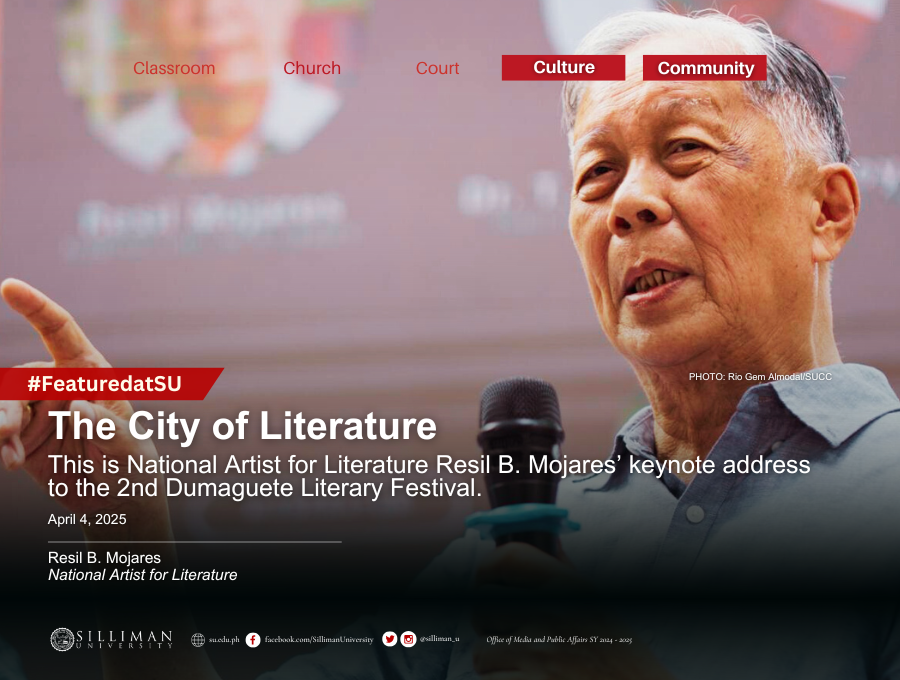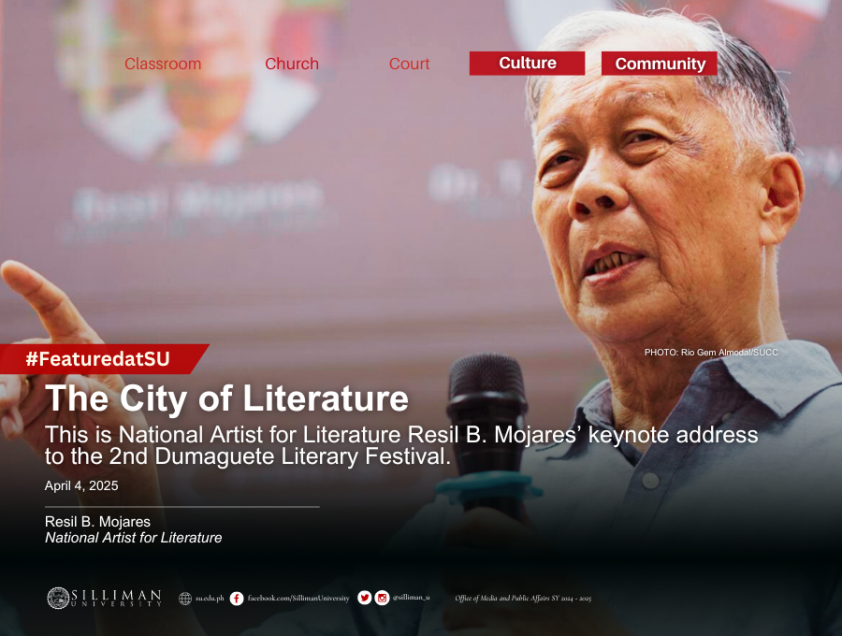
The City of Literature
 By Resil B. Mojares
By Resil B. Mojares
This is National Artist for Literature Resil B. Mojares’ keynote address to the 2nd Dumaguete Literary Festival, Dumaguete City, 4 April 2025.
When I received the invitation to speak at this event, I said to myself this is an invitation I should not refuse. This is not just because this is an important event; I am an alumnus of Silliman University, a fact I was not really conscious about until I learned from a good friend, Ben Malayang, former president of Silliman, that if one studied in the university for at least two years, even if one did not stay on to earn a degree, one is officially an alumnus.
I first came to Dumaguete in 1960, fresh out of high school in my hometown of Dipolog, Zamboanga del Norte. It was a memorable beginning for me: it was my first plane ride, my first time to be away from home, and even the first time—I think—that I started wearing long pants as daily attire since I still remember my mother buying in our town’s public market ready-made pants made in Bohol to prepare me for Silliman.
The Silliman campus was impressive—wide open spaces shaded by big acacia trees, big buildings, and the university’s postcard-perfect seaside location. I imagined it was like attending an American midwestern college: there were quite a number of Americans on campus, activities like weekly convocations in the university chapel, P.E. classes in swimming held in the waters off the Rizal Boulevard; and lights-out in the dorms at 10 o’clock PM. The only form of social dancing on campus was Western square dancing; and when the “panty raids” became a fad in US universities, there were panty raids in Silliman as well, albeit short-lived.
At the heart of all these, of course, was the fact that the university offered a quality education that made Silliman “top choice” in high education, particularly in Visayas and Mindanao. (In my own case, there was a sentimental reason as well for coming to Silliman: my father, who was from Tanjay, attended high school in Silliman as a working student, working as a bus boy in the university cafeteria; he was a Protestant before he converted to being a Catholic a few years after marrying my mother, a Catholic, “to keep the family together,” as he later explained. Today, on my visits to Silliman, it is the university cafeteria I am most nostalgic about, imagining a place that has not changed since my days as a student in the 1960s and perhaps even when my father worked there in the 1930s.)
In Silliman as a student, I recall teachers like the renowned Tiempos, Edilberto and Edith; Margaret Mack in English; Mrs. Rabor in Biology; and, my favorite, Luz Ausejo in History. The university was strong in humanities and the arts. Creative Writing, in particular, was something admired and promoted. (I still have old issues of Sands and Coral, and I recall some of the campus writers at the time). I did not do creative work, however, when I was in Silliman; I was just a new student surveying the field, as it were. I probably would have become a “Silliman writer” had I stayed longer but my mother decided, upon the advice of our town’s parish priest, that it was not seemly to be studying in a Protestant university. (Remember this was the 1960s, years before ecumenism.) And that was how my studies in Silliman ended after two years, in 1963, as I transferred to the University of San Carlos in Cebu City, where I still am—although I have maintained an intermittent association with Silliman’s writing program through the years.
As a further note, I can mention that the very first article I published in an academic journal was one entitled “The Crisis of New Criticism,” which I submitted to the Silliman Journal in 1969 after I had already left Silliman, perhaps acknowledging that this was where my literary education started.
This is a long personal digression. But not exactly. If today many feel that it is most fitting that Dumaguete be named a UNESCO City of Literature, this is because for those who live in Dumaguete and the many writers and lovers of literature who have visited and sojourned in this city, Dumaguete has imprinted itself quite memorably as a city of our affections, and imagination’s home.
I would be exceedingly glad if Dumaguete is declared a UNESCO City of Literature, which will make it the first city in the Philippines and only the second in Southeast Asia (after Jakarta) to be given this distinction.
I have been asked: What makes for a “city of literature”?
There is, to begin with, the tradition, tangible and intangible, of a place that has fostered the appreciation and creation of literature. Most prominent is the presence of Silliman University. Founded by American Presbyterians in 1901, it has from the beginning valued literary education as essential to general education. In this respect, it is a pioneer of sorts. In the United States, college catalogues did not include “creative writing” as a course or program until the 1950s. Yet, in the 1950s, Silliman already had a Silliman Writers Guild, and an annual literary journal called Sands and Coral. In the 1960s (perhaps earlier), what was commonly called a “Department of English” in Philippine universities was, in Silliman, called “Department of Literature and Creative Writing.” Then in 1962, Silliman launched what would become the Silliman University National Writers Workshop, a truly landmark event that featured not only distinguished Silliman writers, like the Tiempos, Ricaredo Demetillo, and others, but also the country’s most prominent writers, like Nick Joaquin, Francisco Arcellana, Kerima Polotan, and others—and a stream of young talents who would in their turn enrich Philippine literature with their own contributions. Said to be the oldest continuing creative writing program in Asia, I recall that there was even a time when there was talk of turning the Silliman workshop into a Southeast Asian Center for Creative Writing.
But what makes for a UNESCO City of Literature? I only have passing knowledge of UNESCO’s criteria for choosing a city as a “city of literature.” Hence, my remarks this afternoon are cursory. It appears to me that the criteria for selecting such a city favor old cultural capitals and primate cities (mostly in the West) that have already accumulated through centuries a vast amount of cultural capital in the form of universities, cultural centers, museums and galleries, a large book industry, and well-endowed programs of grants and recognition. UNESCO criteria include “quality, quantity, and diversity of publishing in the city,” “literary events and festivals that promote domestic and foreign literature,” and “libraries, bookstores, and public or private cultural centers that preserve domestic and foreign literature.”
Obviously, in our case, we cannot think in the image of old European capitals of culture, like Barcelona, Dublin, or Prague (which, it is said, has a concentration of 200 bookshops).
Local contexts and conditions are important, and I would like to think that the UNESCO creative cities program has become more expansive and inclusive than what the published criteria suggest.
In promoting Dumaguete as a UNESCO City of Literature, two things are important. One must not see not only the city’s tradition and current status but the award’s potential and prospective value in raising the city’s visibility and promoting further development that will go beyond the literary field to sectors like tourism, education, and the local economy, as well as diffuse outwards to other places in the country. The stakes are high since Dumaguete is the country’s best bet for being a city of literature and I really think that if Dumaguete does not get this honor, it is unlikely that another Philippine city will.
It is the City that proposes but the national government should be behind this effort. For this reason, it is imperative that the national government and its cultural bodies and agencies, in particular, proactively promote this effort, seeing this as one that will benefit not just Dumaguete but the whole country as model and axis for a more plural, decentered field of literary education, production, and promotion.
What is remarkable about Dumaguete is that it has become, over what is now approaching a century, a de facto city of literature not through a program of state investment but through and spirit of Dumaguete itself, its people, local institutions, and the now hundreds of writers who have adopted Dumaguete as their own “city of literature.”
Today, let us all be inspired by Dumaguete’s campaign to be recognized in the world as a UNESCO City of Literature.


